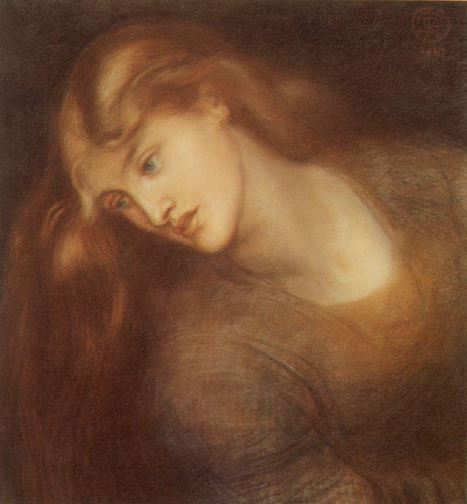
Aspecta Medusa
Dante Gabriel Rossetti (1828-1882)
Signed with a monogram and dated and dated 1867 at the upper right
Coloured Chalks; the sheet was extended at the lower edge
22 x 20 1/2 inches
See commentary below
[Victorian Web Home —> Visual Arts —> Painters —> The PRB and later Pre-Raphaelitism —> Dante Gabriel Rossetti]

Aspecta Medusa
Dante Gabriel Rossetti (1828-1882)
Signed with a monogram and dated and dated 1867 at the upper right
Coloured Chalks; the sheet was extended at the lower edge
22 x 20 1/2 inches
See commentary below
Peter Nahum Ltd, London has most generously given its permission to use in the Victorian Web information, images, and text from its catalogues. The copyright on text and images from their catalogues remains, of course, with Peter Nahum Ltd.
Readers should consult the website of Peter Nahum at the Leicester Galleries to obtain information about recent exhibitions and to order their catalogues. [GPL]
In Greek mythology Medusa was the monstrous daughter of a sea god. Her appearance was horrific; her hair consisted of waving snakes and she was capable of reducing people to stone by looking at them. She was loved by Poseidon with whom she lived in the mythic west. However Perseus came in search of her and slew her. At the moment of her death she gave birth to Pegasus and Chrysaor. The blood from her body was taken by Asclepius; blood from one vein was capable of reviving the dead, whereas that from another served as a lethal dose.
In the history of art the subject of Perseus slaying Medusa is often taken, and the single head of Medusa is also portrayed. From an early time Medusa was represented as a beautiful girl, if with horrible attributes, in contradiction of the accounts of her exceeding ugliness in Greek mythology.
Rossetti wrote poetry which took as its theme Perseus's treatment of the Medusa:
'Andromeda, by Perseus saved and wed,
Hankered each day to see the Gorgon's head:
Till o'er a fount he held it, bade her lean,
And mirrored in the wave was safely seen That death she lived by.
Let not thine eyes know
Any forbidden thing itself, although
It once should save as well as kill; but be
Its shadow upon life enough for thee.'
Virginia Surtees has given an account of the commissioning of this subject, as an oil painting, by C. P. Mathews, in 1867 (I, 107). Mathews was to pay 1500 guineas for the work but in the event rejected the final design on the grounds that he disliked the severed head. The present drawing is a version of the drawing shown to C. P. Mathews, which is in the Birmingham City Museum and Art Gallery.
Provenance: Frederick Leyland; Leyland's sale, Christie's, 28 May 1892, lot 17 (56 gns to McLean); Anonymous sale, Sotheby's, 27 April 1966, lot 235 (EI80 to David Hughes); Stone Gallery, Newcastle-upon-Tyne; L. S. Lowry, RA
Newall, Christopher. A Celebration of British and European Painting of the 19th and 20th Centuries. London: Peter Nahum, nd [1999?]. Pp. 22-24.
Rossetti, William Michael, ed., Rossetti Papers 1862-70. London, 1903. P.244.
Surtees, Virginia. Dante Gabriel Rossetti. 2 vols. Oxford: Clarendon Press, 1971. Catalogue no. 183E. I, 107.
Last modified 16 March 2006